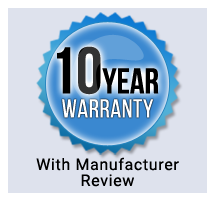USES/HISTROY
EPDM (Ethylene-Propylene-Diene-Monomer)
EPDM rubber is used in vibrators and seals; glass-run channel; radiator, garden and appliance hose; tubing; washers; belts; electrical insulation, and speaker cone surrounds. It is also used as a medium for water resistance in high-voltage polymeric cable jointing installations, roofing membrane, geomembranes, rubber mechanical goods, plastic impact modification, thermoplastic, vulcanizates, as a motor oil additive, pond liner, electrical cable-jointing, RV roofs, and chainmail applications.
The main properties of EPDM are its outstanding heat, ozone and weather resistance. The resistance to polar substances and steam are also good. It has excellent electrical properties. It has the ability to retain light colour.
Liquid Rubber is designed to recoat structurally sound existing roof and protective materials. They should not be used in place of roofing membranes".
The following are recommended substrates to coat:
- Metal - Coated or Galvanized SteelM
- Weathered Aluminum
- Weathered Copper
- EPDM Rubber membrane
- Fish Ponds and Fountains
- Concrete (except foot traffic surfaces)
- Urethane Foam
- Primed Wood
- Fiberglass
- PVC Sheet and Pipe
- Acrylic Sheet
- Sponge Rubber insulation
- Built up asphalt roofs
- Asphalt shingles
- Modified asphalt roll roofing
- Stainless steel
- Glass
- Silicone caulk
- Foot traffic surfaces
- Hypalon Membrane
EPDM is excellent for both new construction and roof replacement. It is capable of withstanding temperature variations from -62F to 300F without cracking or deteriorating. EPDM offers high tensile strength, extreme elongation capabilities, and is generally compatible with other materials used in most roofing applications.
EPDM Rubber and Rubber Roof has a long history of superior performance in hoses, molded products, roof leaks repair, tires and roofing membranes. For example, the radiator hoses in our cars and the gaskets on our freezer doors are made of EPDM rubber and show the broad temperature range the product can handle. EPDM Roofing Membranes also have more than 30 years of successful history. EPDM is relatively inexpensive, simple to install, and fairly clean to work with when compared to conventional materials. There are not the strong odors and fumes either. The product is very stable and the resulting characteristics of Liquid EPDM and Liquid Roof Rubber such as flexibility, weather ability and chemical resistance are determined by it. Liquid EPDM therefore, can be described as a new form of an old and well-established rubber polymer. Now you can take advantage of the same benefits to weather-tight your leaks. Liquid EPDM forms a 100% seamless layer. No other product can match the durability of EPDM Liquid Roof Repair Products.. EPDM is essentially immune to the effects of ultraviolet and ozone and is one of the best water barriers known. EPDM Rubber also has the broadest temperature tolerance, and is not water-soluble even in the uncured state. Even if you happen to get a unexpected rain shower just after you applied Liquid EPDM there's no need to worry; Liquid EPDM will not wash off.
Liquid EPDM Rubber vs. Neoprene Rubber
Early in the flexible membrane market explosion, owners and contractors recognized EPDM roofing as a cleaner, cooler and generally easier product to handle than the built-up roof (hot tar or asphalt) to which they were accustomed. With very little capital investment, they were able to obtain all the tools and equipment needed to properly install an EPDM roof. These systems also offer low maintenance, easy repair options and low annualized cost. EPDM rubber was not available in liquid form until relatively recently so Liquid Neoprene rubber became the material of choice for protecting concrete Roof against both fresh and salt water. The Liquid Neoprene products are simple solvent solutions or water based emulsions and therefore has low solids content and relatively low molecular weights. These limitations made multiple coat applications necessary and required top coating with other polymers to prevent ultra violet degradation. Liquid Rubber also provide a strong solution for all type of roof leaks repair and Roof sealant repair. All type of metal roof, RV roof, commercial and residential roof leaks repair.
The development of Rubber resulted in a high solids, two components chemically reactive product capable of polymerizing at ambient temperatures 55 F (13 C) and higher. This product can be applied at a 30 mil dry film (.76 mm) in a single application because of the high solids content. Its chemical cure feature then results in a high molecular weight film with protective and performance properties exceeding those of liquid applied Neoprene films.
EPDM Rubber can withstand boiling water or live steam and is inherently UV and ozone stable. The product is safer to use because of its higher flash point and the two component packaging permits extended storage at higher temperatures than liquid Neoprene. The non polar characteristic of the EPDM also gives it advantages over Neoprene in saltwater environments as well as better resistance to cathodic disbondment. Liquid rubber has poor resistance to oils, fats, waxes and aliphatic solvents but possesses very good resistance to ketone solvents, alcohol, polar compounds, Salts, most acids up to 50 % concentration, alkalies and water.







